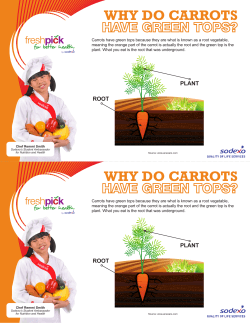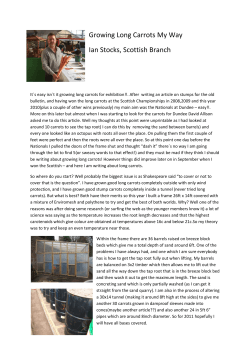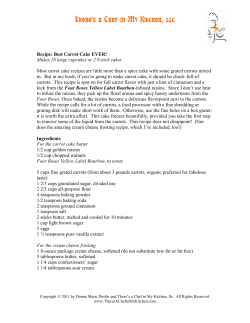
Production guidelines for Carrot agriculture, forestry & fisheries
Production guidelines for Carrot agriculture, forestry & fisheries Department: Agriculture, Forestry and Fisheries REPUBLIC OF SOUTH AFRICA Production guidelines for Carrot DEPARTMENT OF AGRICULTURE, FORESTRY AND FISHERIES Directorate Plant Production Obtainable from Resource Centre Directorate Agricultural Information Services Private Bag X144, Pretoria, 0001 South Africa The web: www.daff.gov.za/publications Published by Directorate Agricultural Information Services Department of Agriculture, Forestry and Fisheries Private Bag X144, Pretoria, 0001 South Africa For further information please contact Directorate Plant Production, Division Vegetable Crops Tel: 012 319 6072 Fax: 012 319 6372 E-mail: DPP@daff.gov.za Disclaimer This document has been compiled by the Department of Agriculture, Forestry and Fisheries and has made every effort to ensure accuracy and thoroughness of the information contained herein and all liability for any errors, omissions or inaccuracies in such information and data, whether attributable to inadvertence or otherwise. The Department of Agriculture, Forestry and Fisheries therefore accepts no liability that can be incurred resulting from the use of this information. CONTENTS CONT CO NTEN ENTS TS Part i: 1. 2. 3. 4. 5. 6. 7. General aspects Classification ......................................................................... Origin and distribution ........................................................... Major production areas in South Africa ................................. Description of plant ............................................................... Cultivars ................................................................................ Climatic requirements............................................................ Soil requirements .................................................................. 1 1 1 1 2 3 3 Part ii: 1. 2. 3. 4. 5. 6. 7. 8. 9. 10. Cultivation practices Propagation .......................................................................... Soil preparation ..................................................................... Planting ................................................................................. Fertilisation ........................................................................... Irrigation ................................................................................ Weed control ......................................................................... Pest control ........................................................................... Disease control ..................................................................... Other cultivation practices ..................................................... Harvesting ............................................................................. 3 3 4 4 4 5 5 5 6 6 Part iii: 1. 2. 3. 4. Post-harvest handling Sorting and grading ............................................................. Packing ................................................................................ Storage ................................................................................. Marketing .............................................................................. 7 7 7 7 Part iv: Production schedule ............................................................. 8 Part v: Utilisation .............................................................................. 9 References ........................................................................................... 9 Part i: General aspects 1. Classification Scientific name: Daucus carota L. Common names: Carrots Family: Apiaceae/Umbelliferae 2. Origin and distribution Carrot is believed to have originated in Afghanistan which remains the centre of diversity of D. carota. They were known to the Greeks and the Romans and their early use was mainly medicinal, to cure stomach problems and treat wounds, ulcers, and liver and kidney ailments. Carrots were established as a food crop in India, China and Japan by the 13th century. The greatest development and improvement of the original wild carrot that had thin, long roots took place in France. Carrots are now a popular vegetable grown all over the world. 3. Major production areas in South Africa 3.1 South Africa In South Africa, carrots have been an important vegetable crop since the early settlement at the Cape. Carrots are grown all over South Africa particularly near urban areas. They are cultivated in Stellenbosch, Johannesburg, East Rand, Pretoria, Greytown, Weenen and in the Reddersburg area in the Free State. 4. Description of the plant The carrot is an erect, biennial plant, 30-100 cm in height. 4.1 Roots The root is the edible part and it is basically a swollen base of the tap root that also includes the hypocotyls. It is conical and its length varies from 5 to 25 cm. The colour of the roots varies from white, yellow, orange-yellow, light purple, deep red to deep violet. 4.2 Stem The stem consists of a small plate-like ‘crown’. 1 4.3 Leaves Leaves are produced in the first season. They have long petioles and are pinnatelyy compound. p 4.4 Flower The inflorescence is a terminal compound umbel, subtended by pinnatifid bracts. The flowers of the umbel are white except for the central ones which are either red or purple. Flowers are produced in the second year. 4.5. Seeds Like flowers, seeds are produced in the second year. Carrot seeds contain essential oils. 5. Cultivars Carrots are classified into four major types based on root shape and storage capability: 1. Chantenay This type has very strong foliage and its roots are broad in the shoulder, relatively short and blunt tipped. They have a strong pale-coloured core and stores well. The main use is for processing. 2. Nantes Nantes types have sparse foliage that is weakly attached to the crown. The root is moderately long with a uniform diameter along the length and a rounded tip when mature. The surface is thinner and easier to scar. The highly pigmented core is poorly developed making roots brittle and it matures early. Nantes is less suitable for long-term storage owing to the fact that roots have higher sugar content, lower in terpenoids and lower dry matter. 3. Danvers The Danvers type has strong foliage with roots that are moderately wide in the shoulder, pointed and longer than Chantenay types. Core development is strong with medium pigment. This type stores well and is used in processing and fresh market. 4. Imperator Imperators have strong foliage and roots that are narrower in the shoulder than Danvers type. The roots are long and slender, tapering to a pointed tip. 2 Core development is moderate and medium pigmented. It has good storage quality and is used for the fresh market. 6. Climatic requirements 6.1 Temperature The carrot is a cool weather crop and it also does well in warm climates. The optimum temperature for growth is between 15 to 20 °C. Temperatures below 10 °C cause longer, more slender and paler roots. Shorter, thicker roots are produced at higher temperatures. Extended periods of hot weather can cause strong flavour and coarse roots. Development is also slower in winter than in spring and summer. 6.2 Rainfall Carrots require a steady supply of moisture and it must be maintained at above 50 % of available moisture throughout growth. Generally, carrots require approximately 25 mm of water per week but under warm, dry conditions 50 mm will be required. 7. Soil requirements Deep, loose, well-drained sandy to loamy soils, not subject to capping. with a pH of 6.0 to 6.5 are ideal for carrot production. The crop produced in humusrich soils tends to increase in foliage excessively and forms forked and hairy carrots. The roots also tend to be more rough and coarse on the outside. Brack soils should also be avoided as carrots are very sensitive to saline soils. Part ii: Cultivation practices 1. Propagation Carrots are only propagated by means of seeds. 2. Soil preparation The soil should be well tilled and as level as possible in order to obtain a good stand. It must have a good crumbly structure and kept moist enough to allow seed germination. Therefore the soil must be deep ploughed to loosen the soil to a depth of at least 30 cm. The soil should be fumigated for nematodes. 3 3. Planting The rows are generally spaced from 200 to 400 mm apart. In double or triple rows,, the width between sets of rows range g from 400 to 600 mm. Row spacp ings in baby carrots production may be 100 mm. A planting density of 150 to 160/m2 gives good results in double rows whereas a density of 100/m2 is ideal for single rows. The seeds are directly sown in the field on ridges or raised beds. Row planting is preferred to broadcast sowing. The seeding depth should be 10 to 25 mm or 40 mm in loose, light sands. Planting depth should be shallow on heavier soils and in colder months. Slightly deeper planting is recommended in summer when the soil dries out quickly. The chance of a successful establishment of the crop will be increased if the seed is sown in moist soil and only if the soil is kept moist. 4. Fertilisation Fertiliser recommendations should be based on soil analyses. As a general guide, 100 kg/ha fertiliser mixture of 2:3:4 (24) should be worked into the soil before planting. Limestone ammonium nitrate at a rate of 100 to 200 kg/ha should be applied as a topdressing approximately 8 weeks after planting. Compost or organic manure should not be applied since they cause unattractive, hairy roots, with a coarser texture. Carrots have low nitrogen requirements and good yields can be obtained with 80 kg/ha of nitrogen applications. Nitrogen can be applied at planting and the remainder at 4 to 8 weeks. Forty kilogrames of phosphorus per hectare are sufficient to produce a good crop. The crop has a high potassium requirement and half is applied as side dressing at 4 to 8 weeks after planting. The balance is applied as late dressings. 5. Irrigation The soil should never be allowed to dry out. Too much moisture causes short carrots with light colour and a larger diameter. The field should be irrigated lightly immediately after sowing. Irrigation water should be applied once or twice a day using a solid-set sprinkler system. Watering should gradually be reduced to prevent longitudinal splitting of the roots when the crop approaches maturity. Water stress during root development also causes cracking of the roots, which also become hard. 4 6. Weed control Soil cultivation between the rows is carried out at an early stage merely to control weeds. Weeds should not at anyy time be allowed to compete p with crop. Weeds can be controlled mechanically, by hand, using a hoe ,chemically or by combining all these methods. 7. Pest control 7.1 Aphids (Aphis fabae, Myzus persicae) Colonies of aphids sometimes occur on the leaves and crowns, and flower stems of carrots. They suck the sap from the plants resulting in retarded growth, yellowing and restricted seed production. CONTROL Control can be achieved by spraying with a registered pesticide. 7.2 Red spider mite (Tetranychus cinnabarinus) Red spider mite is generally not a serious pest in carrots but the numbers can increase rapidly as it gets warm. CONTROL Cutworms can cause problems throughout growth. They cut young seedlings after emergence and feed on or around the carrots shoulders later in growth. Cutworms can be controlled by applying registered pesticides. 8. Disease control 8.1 Alternaria blight (Alternaria dauci) Symptoms are dark brown to black spots, some with a yellow edge, appearing on the leaves. The oldest leaves are more susceptible than younger ones. The petioles and roots can also be affected. It can be transmitted with the seed and cause damping-off of the seedlings, and usually occurs during wet weather. The disease can be controlled by disinfecting seed with a seed dressing containing thiram m or captab b or sowing certified seed. In areas where blight is a problem, carrots should not be cultivated on fields that remain damp for long periods in the morning after dew. Crop rotation can be practised. 5 8.2 Bacterial blight (Xanthomonas carotae) This disease is characterised by brown spots developing on the leaves and brown stripes p on the p petioles. In seed crops p the flower stems and inflorescence can be affected, whereas in carrots brown, horizontal lesions appear on the leaves. CONTROL Disease-free, certified seeds should be sown. 9. Other cultivations practices 9.1 Thinning Thinning is usually necessary in carrot production and should be carried out when the ground is moist, preferably late in the afternoon. 10. Harvesting 10.1 Harvest maturity Carrots are harvested when they have reached a diameter of 20 mm and more, still young and tender. When very slender carrots are needed for certain markets or for baby carrots, harvesting can commence earlier. Usually when the carrots have reached the mature stage, their base tips appear on the soil surface. 10.2 Harvest methods Carrots are harvested when they have reached a diameter of 20 mm and more, still young and tender. When very slender carrots are needed for certain markets or for baby carrots, harvesting can commence earlier. Usually when the carrots have reached the mature stage, their base tips appear on the soil surface. 6 Part iii: Post-harvest handling After harvesting, the carrots are placed in a shade at the field in crates before washing. Carrots should be washed carefully to cause as little damage as washing possible to the root surface. 1. Sorting and grading Carrots are sorted by hand to remove broken or split roots. 2. Packing Baby carrots and those with very fine roots are usually packed in pre-pack containers and leaves are normally removed. Perforated plastic bags, mesh pockets, or cartons are other materials used for packaging. Uniformity of root size is very important when packing carrots because it enhances the presentation during marketing. 3. Storage After harvesting, if necessary, carrots can be put in cold storage for 6 months with good results. The best results are obtained where the humidity is above 90 % and the temperature is approximately 0 °C. 4. Marketing Carrots together with their leaves are still mostly sold in bunches of five to ten. When sent to distant markets, carrots are sold without their leaves and in small bags. In self-service shops carrots are sold without leaves in transparent plastic bags. For processing, the leaves are cut off in the field and the carrots are placed in bags or plastic containers and sent unwashed to the factory. 7 Part iv: Production schedule DECEMBER NOVEMBER OCTOBER SEPTEMBER AUGUST JULY JUNE MAY APRIL MARCH FEBRUARY JANUARY ACTIVITIES Soil sampling X X X Soil preparation X X X Planting X X X X Fertilisation X X X X X X X Irrigation X X X X X X X Pest control X X X X X X X X X Disease control X X X X X X X X X Weed control X X X X X X X X X Harvesting Marketing X X X X X X 8 X X X X X X X X Part v: Utilisation Carrots are consumed fresh as a salad crop or cooked. They are also processed either alone or mixed with other vegetables vegetables. The juice is extracted and used as a drink.Tender roots are pickled or made into jams and sweetmeats in some countries. Carrot cake and carrot pudding can also be made. The aromatic seeds are used as a stimulant and to relieve flatulence. Whole plants can also be used as fodder for cattle and horses. Carrots are said to be rich in ß-carotene, dietary fibre, antioxidants and minerals. REFERENCES http://en.wikipedia.org/wiki/Carrot http://www.browfarm.co.uk/carrots_about.htm http://www.gov.ab.ca Joubert, T.G, Boelema, B.H., Daiber, C.C. & Hattingh, I.D. 1980. The production of carrots in South Africa.Root Crops A.2/1980. Farming in South Africa. Kochlar, S.L. 1986. Tropical Crops: a Textbook of Economic Botany. Macmillan Publishers. Kotecha, P.M., Desai, B.B. & Madhavi, D.L. 1998. Carrot. Pages 119 – 139. In Handbook of Vegetable Science and Technology: Production, Composition, Storage and Processing. Salunkhe, D.K. & Kadam, S.S. (Eds). Marcel Dekker, Inc. New York. 9
© Copyright 2025














